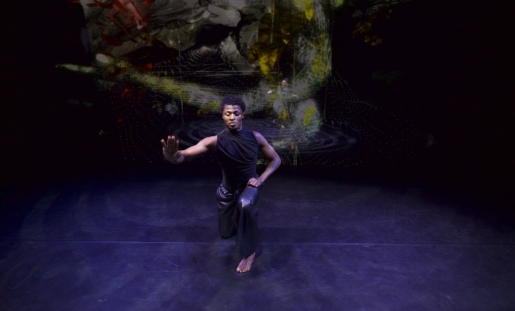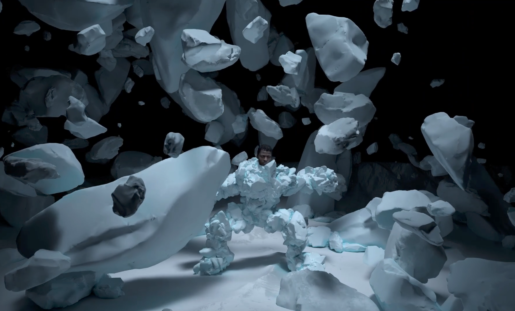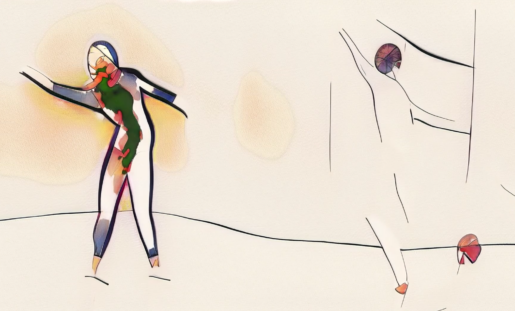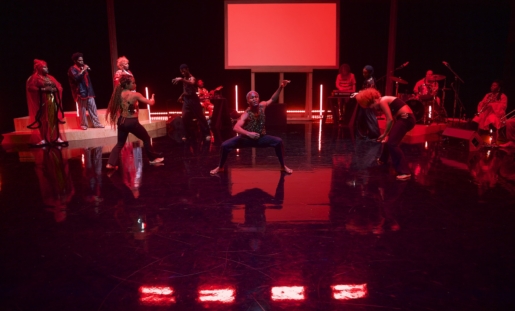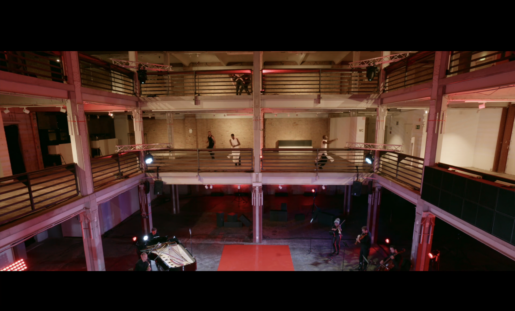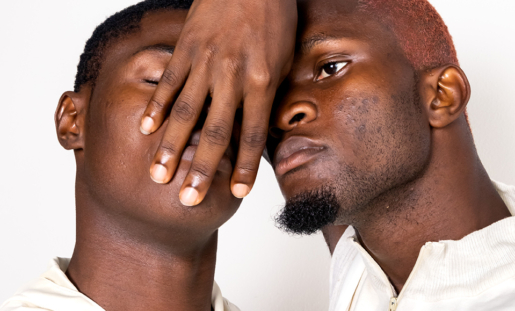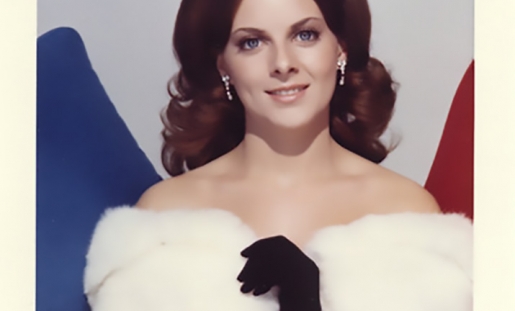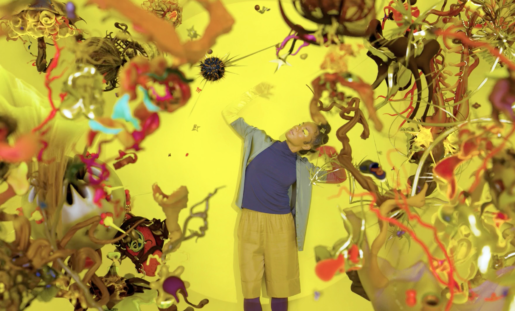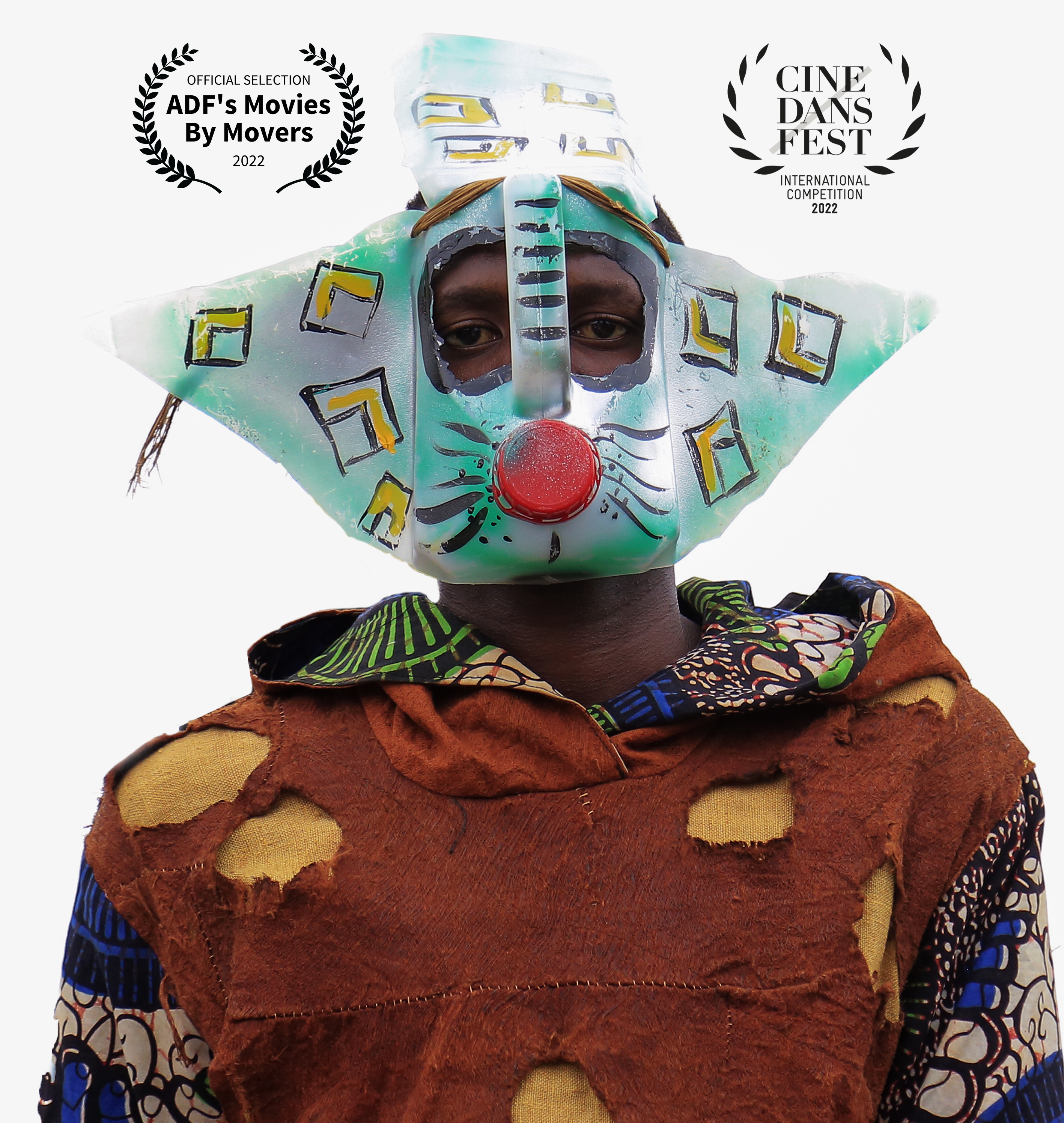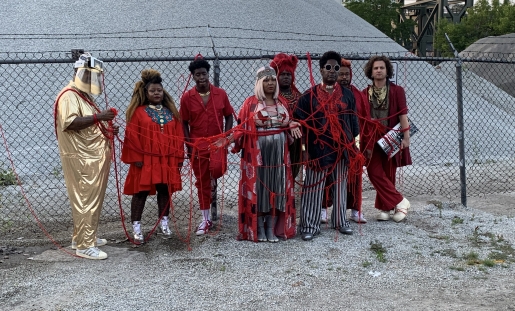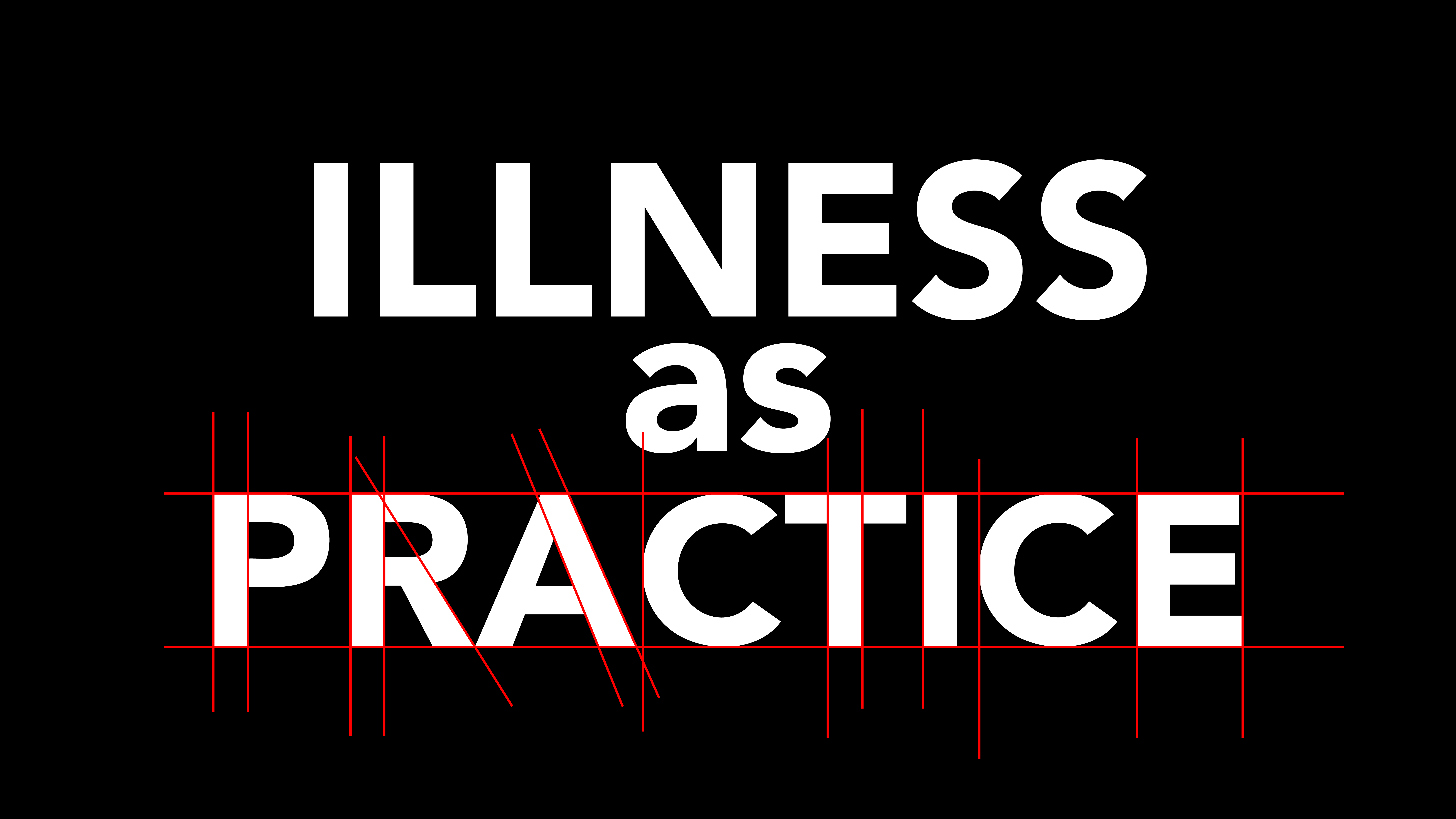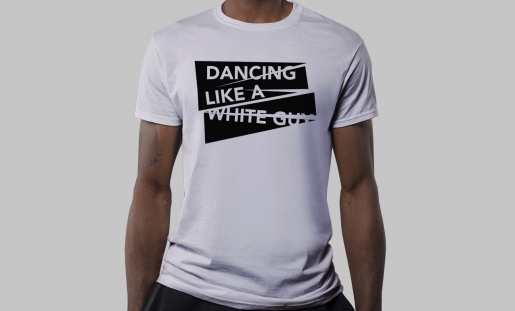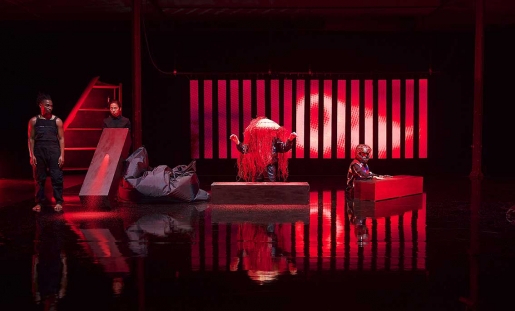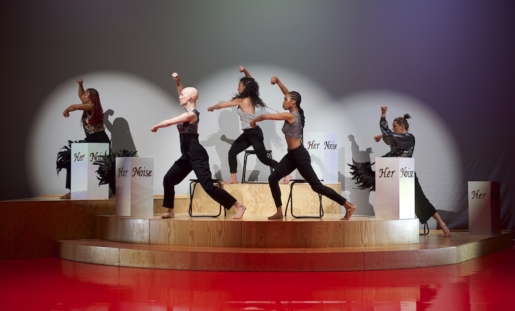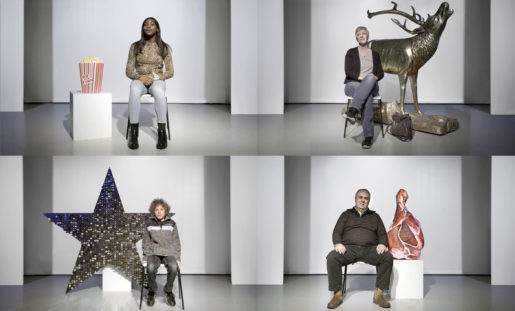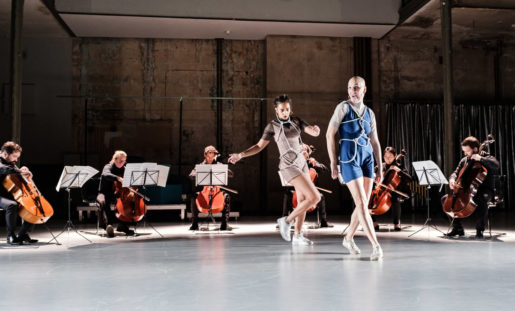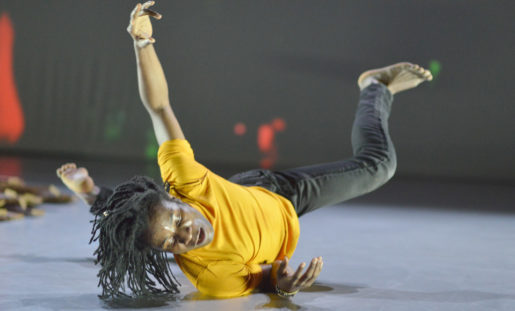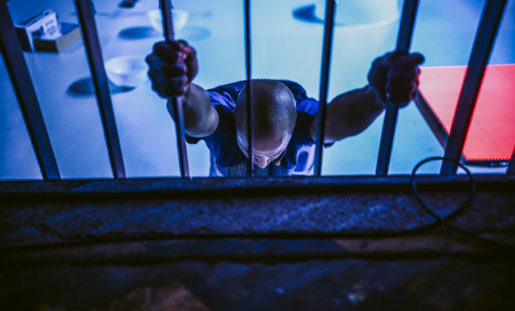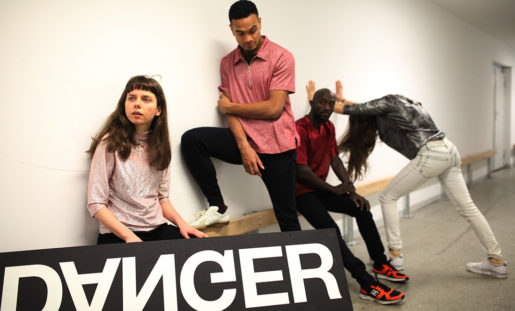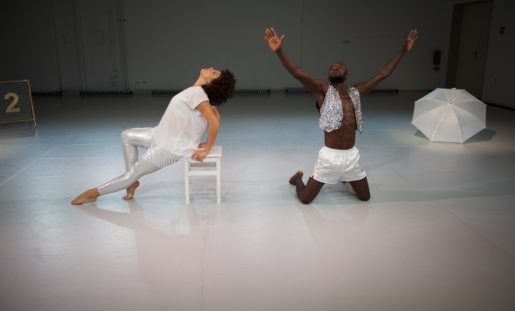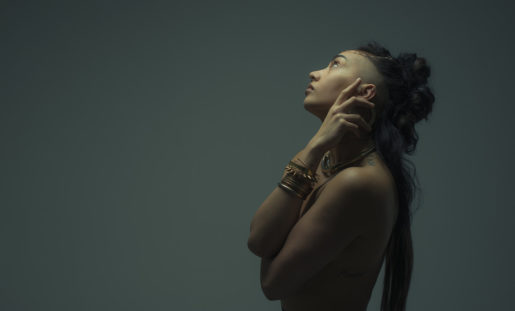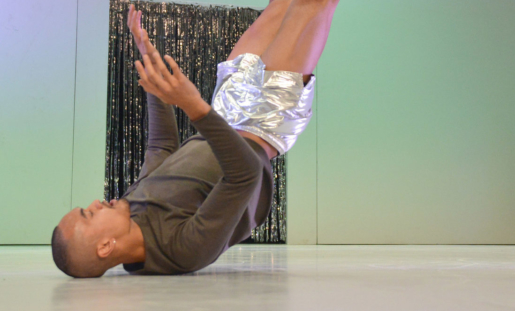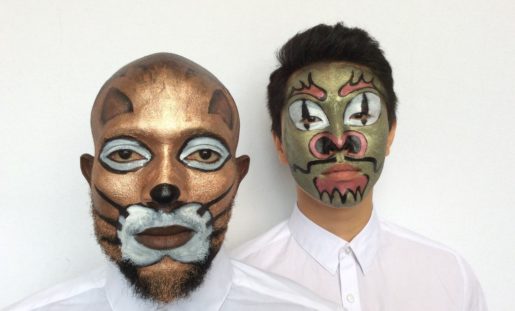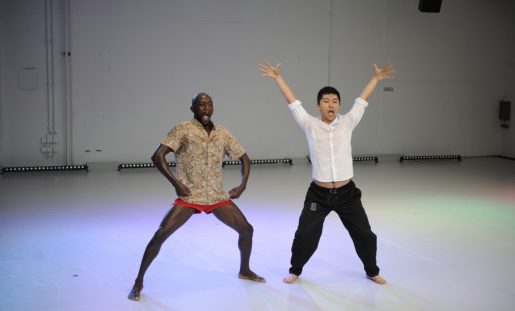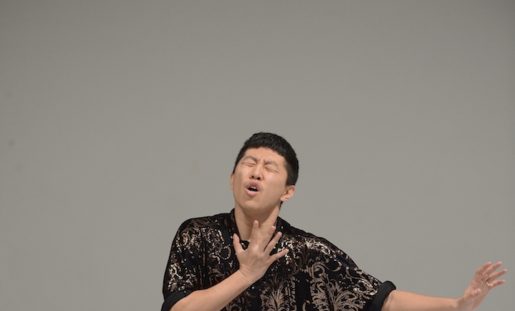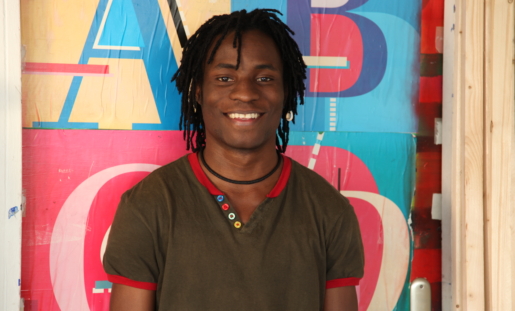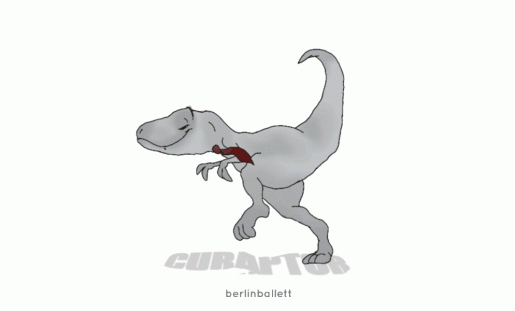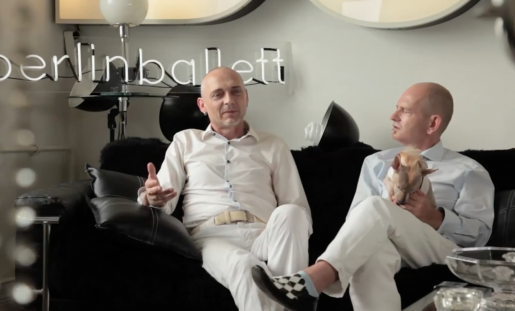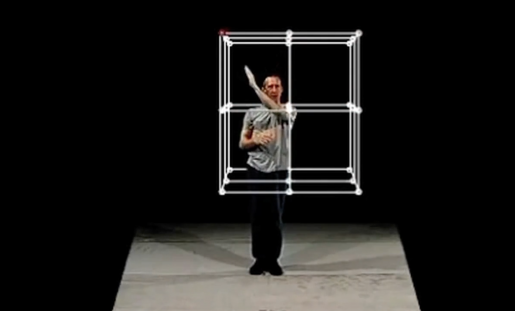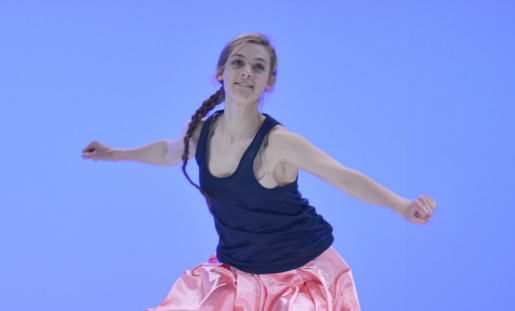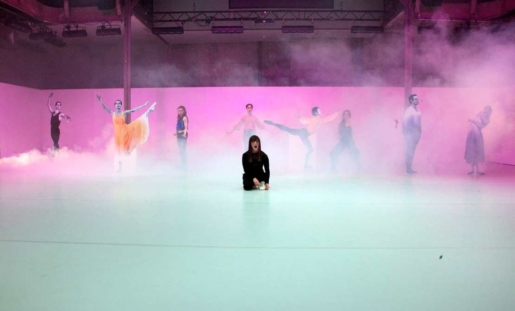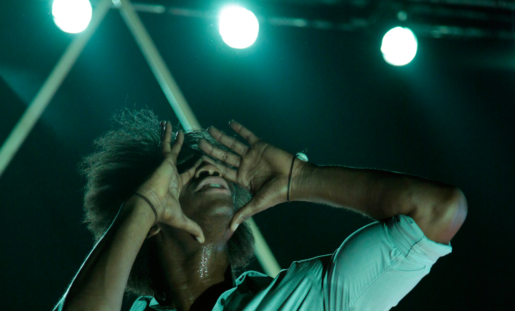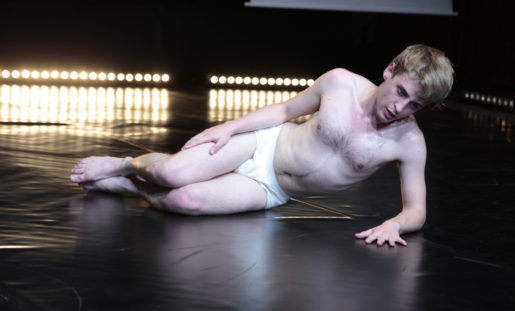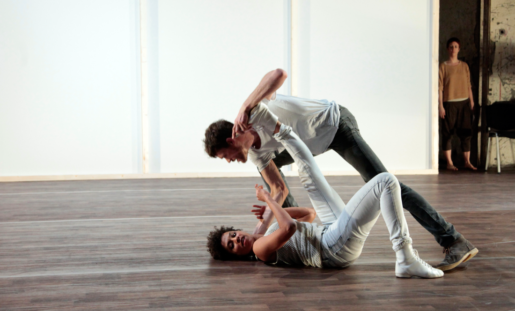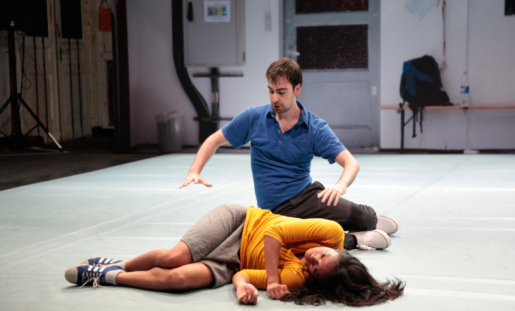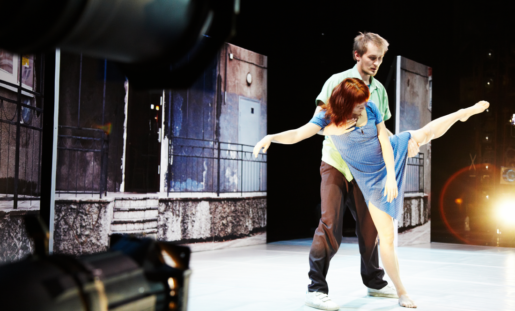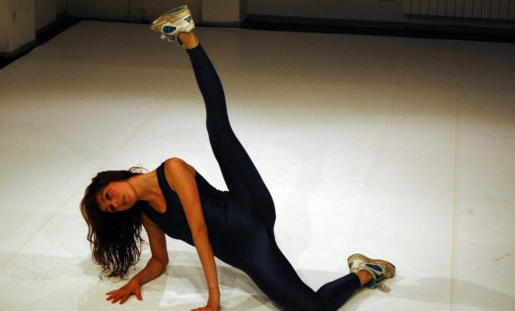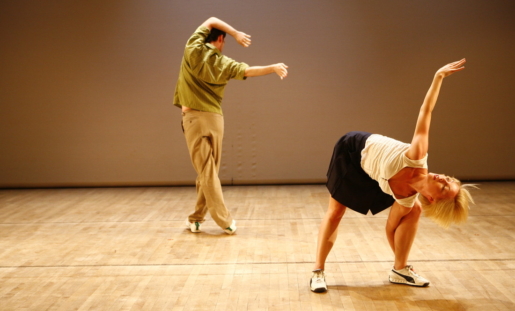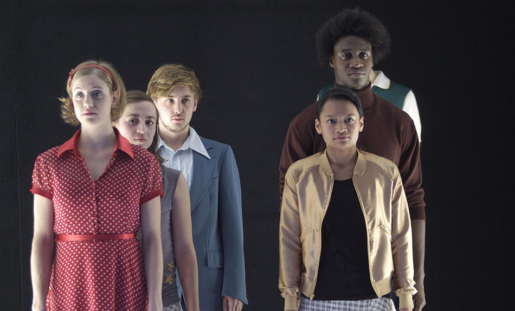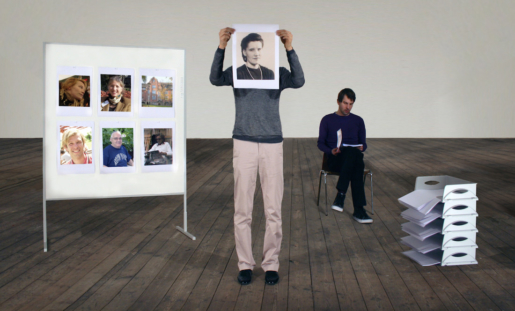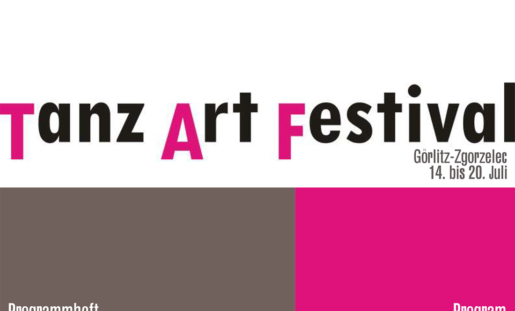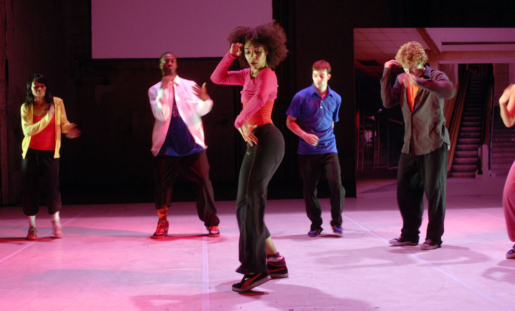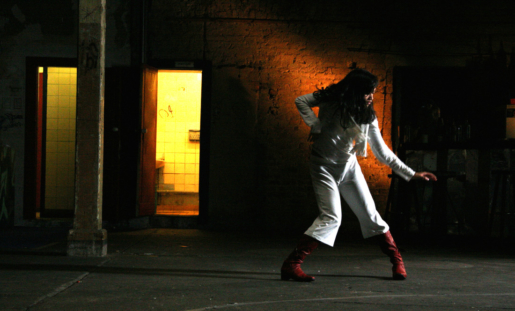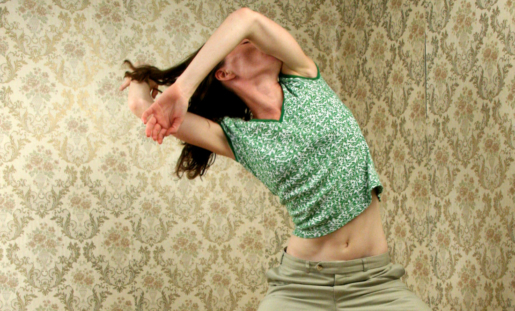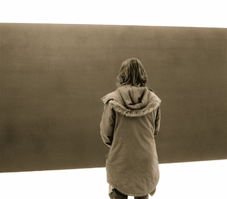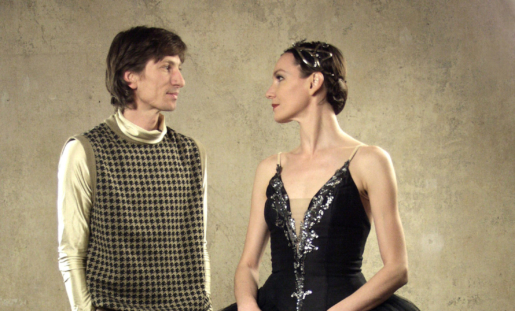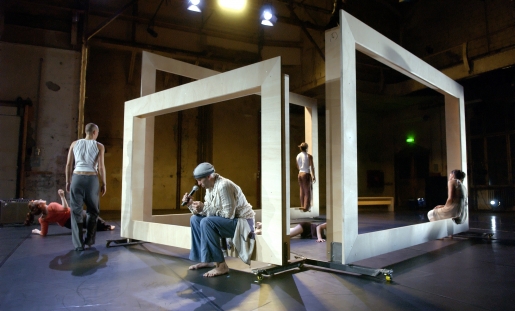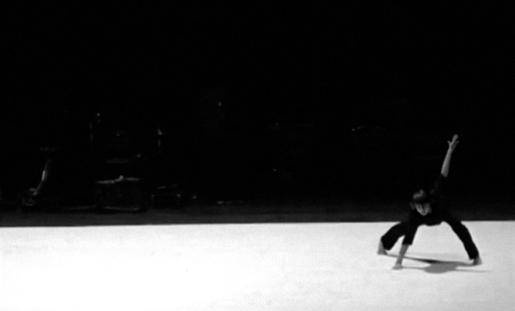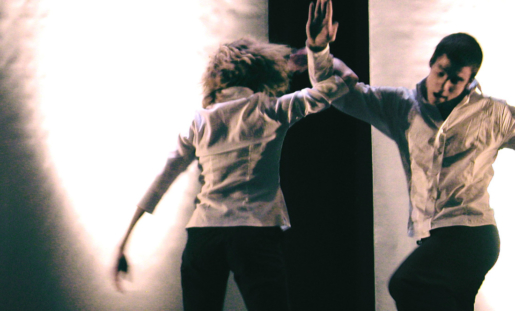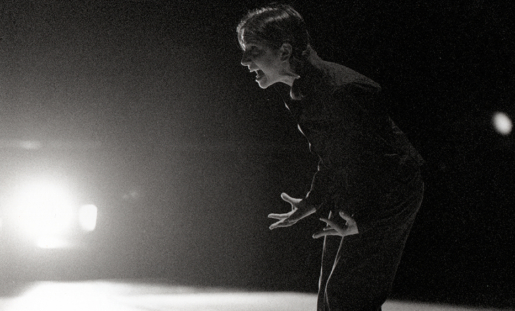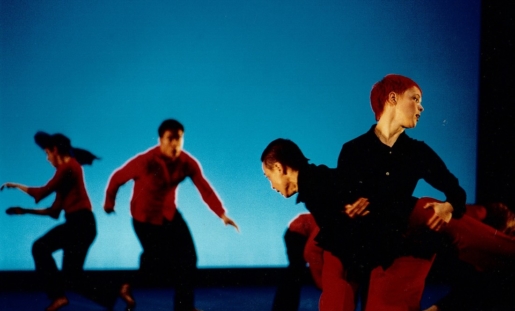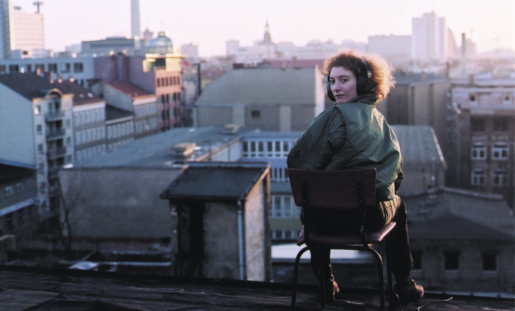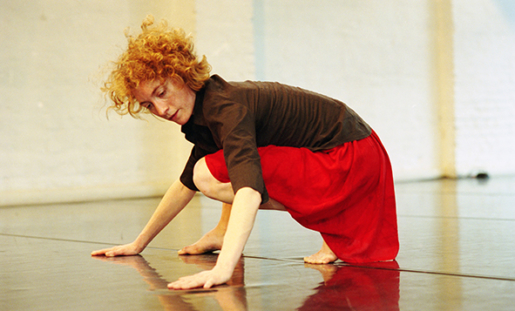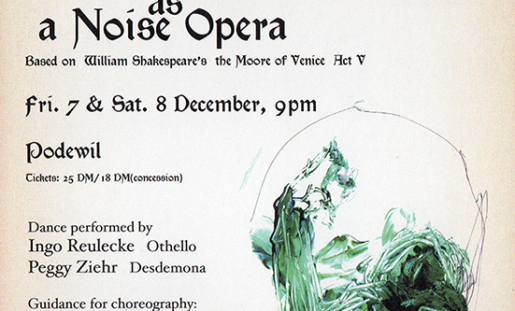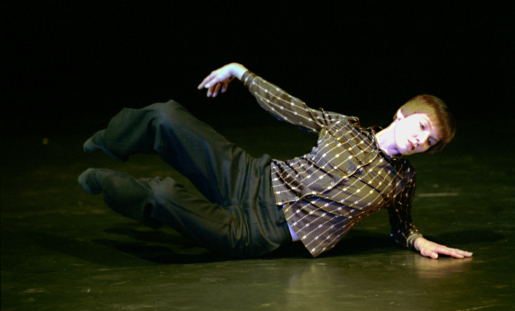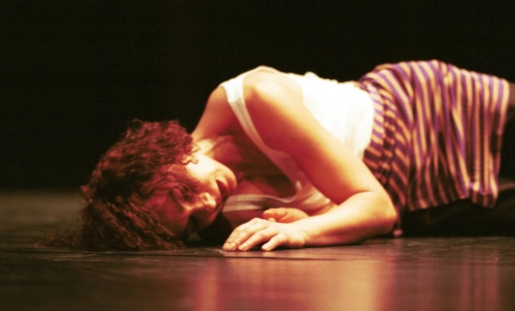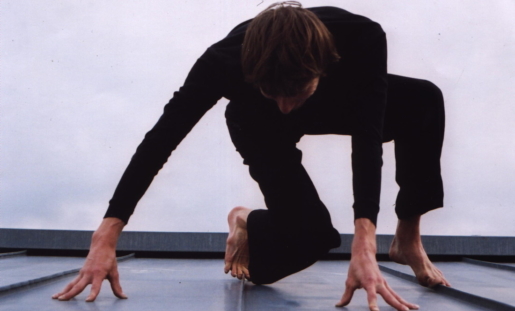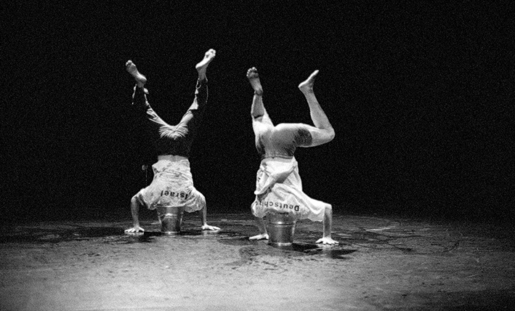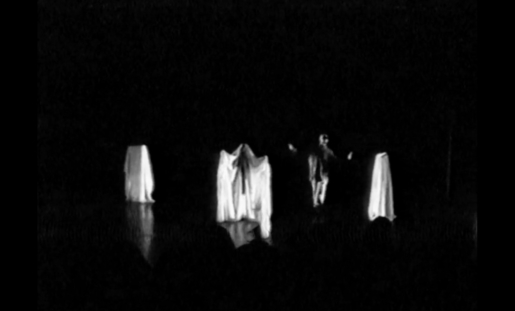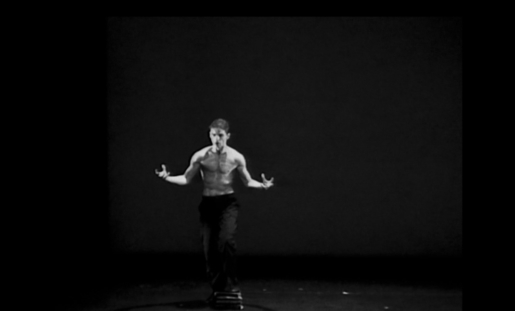The "Four Non Blondes" project takes an essay by US author Claudia Rankine as an opportunity to explore the phenomenon of "blondness". C. Rankine was asked at a dinner with female university lecturers how they should react when their Black students bleach their hair blonde. She was unable to give a clear answer and began to deal with this topic in the long term. This resulted in an essay about blondness and the ambivalences associated with it.
Four Non Blondes
Songs & Dances about the Weather
The project combines stories about African rainmaking rituals with the poetic representation of climate data of melting glaciers in Europe. In this way, two phenomena of "disappearance" are brought into connection and made tangible with the help of three-dimensional projections.
OKUBULA KWA BALAFU [eng. On the Disappearance of the Glaciers]
The project was a research project on the artistic representation of climate data for performative scenarios. Using a data set on the worldwide retreat of glaciers, we found possibilities to translate this data into other media in order to be able to use it better in performative contexts.
Scores for the Virtual
A research project on the creation of AI-based dance notations
The project deals with the question of whether and how machine-based learning methods can be used to create an algorithm that is capable of developing dance scores.
It is planned for several years and will be continued by the company after the research phase.
With:
We Are Going To Mars – a choreographic concert
The choreographic concert We Are Going To Mars follows the two video works of the same name by the company Christoph Winkler, which celebrated their online premiere in November 2021: In a mixture of video, dance and music, the participating artists examined the history of the first African space programme in Zambia and its reception over the past 50 years. They also build a bridge to the work of the Afro-American musician Sun Ra, who developed his credo "Space is the place" at the same time.
Stay On It
"Stay on it" is a dance film based on the company's stage play of the same name.
The dancers were asked to place and develop their material in the spaces of the Kühlhaus Berlin and to develop it further.
Radical Minimal
With its new project “Radical Minimal”, the Christoph Winkler Company of Berlin seeks new perspectives on the interplay between minimal music, contemporary dance and diversity. To this end, the artists will examine three well-known, classically abstract pieces of minimal music and reinterpret them using their own, thematically oriented choreographies: “Come Out” by Steve Reich, “Coming Together” by Frederic Rzewski and “Stay on It” by Julius Eastman. The development of the choreographies will tie into their reception history in music and dance, as well as their connection to the American civil rights movement.
Faces
„Skin tone reproduction is not just science. It has to deal with the psychology
of how people WANT to look“ L. Roth
With:
What If
The starting point for this work was a short text by the American author Claudia Rankine, taken from her book "Just Us". C. Rankine has become known for her precise observations of everyday racism in the U.S. She focuses on what she calls "micro-aggressions" - a very subtle racism that never becomes loud but is deeply rooted in the thinking and feeling of large parts of the American population.
We are going to Mars | and we’ll unite the galaxies |
"Our spacecraft, Cyclops I, will soar into deep abysmal space beyond the epicycles of the seventh heaven" The Zambian Space Program Manifesto
We are Going to Mars uses international video works to explore the history of the first African space program and how the reception of this story has changed over the past fifty years. Moreover it builds a bridge to the work of the African-American musician Sun Ra who developed in the same historical period his Credo “Space is the place”. The first part of the project was realised in collaboration with the Ugandan
independent dance scene.
With:
- Anna Tracy Aguti,
- Anthony Okiria,
- Ark Martin Kyaligamba Kisiti,
- Arsenal,
- Asaph Kasujja,
- Bosco Kitabira,
- Brian Kisembo Delon,
- Dance Theatre Uganda,
- Davis Ahimbisibwe,
- Denis Lule,
- Denis Magezi,
- Edison Musanje,
- Edward Jjombwe,
- Eric Mukalazi,
- Fausta Nakasujja,
- Gabriella Fiore,
- Godfrey Natuhwera,
- Habib Mbogo,
- Herbert Jovan Simbwa,
- HHY & The Kampala Unit,
- Ian Elijah Ssenkungu,
- IGC Fashion,
- Intare Performers,
- Ivan Clark Niwamanya,
- Jeff Musoke,
- Joan Nakawombe,
- Joana Mbabazi,
- Joel Kakande,
- Joel Kateeba,
- Julius Musenze,
- Kino Musoke,
- Kizza Moses,
- Kwizera Gideon,
- Lydia Kasirye Nanozi,
- Mario William Mayega,
- Martha Naggita,
- Moses Mukalazi,
- Mourning [A] BLKstar,
- Mugera Spin Godfrey,
- Noah Bemuka,
- Prisca Atite,
- Richard Kasosi,
- Richard Tamale,
- Robert Ssempijja,
- Salama Natabi,
- Shafic Walusimbi,
- Shane Munina,
- Sosolya Undugu Dance Academy,
- Stuart Etou,
- Umar Kareregga,
- Walter Ruva,
A Beginner’s Guide To Worldbuilding
You, Need, Go, Search, Find, Take, Return, CHANGE: With the means of dance, the solo looks at methods of world and character building that assert the plannability of fantasy. What happens when they encounter the unpredictable and the vulnerability of the moment in a performance?
With:
We are going to Mars | Suite |
We are Going to Mars uses international video works to explore the history of the first African space program and how the reception of this story has changed over the past fifty years.
Moreover it builds a bridge to the work of the African-American musician Sun Ra who developed in the same historical period his Credo “Space is the place”.
The second part of the project was created in collaboration with Symara Johnson and dancers from New York.
Mapping Environmental Dance
www.environmental-dance.com
The interactive website environmental-dance.com combines knowledge of the earth's climatic changes with traditional and contemporary dances from around the world that reflect human beings and their integration into nature. The aim of Environmental Dance is to make climate change tangible and visible on different levels, using dance, scientific data and personal testimonies from many countries around the world.
With:
- Adilso Machado,
- Ahmed Soura,
- Alex Ssebaggala,
- Alexander Madriz,
- Aloalii Naughton Tapu,
- ANUnaran Jargalsaikhan,
- Boogie Papeda,
- Brandon Yoon,
- Chino Neri,
- Compagnie Debass,
- Daloy Movement,
- Dawit Seto,
- Diana Bayardo,
- Diana Teresa Gutiérrez Garcia,
- Douglas Koirewoa (D’krump),
- Ea Torrado,
- Eisa Jocson,
- Elisa Cucinelli,
- Eliz Queen Andika,
- Eloi Hortense N’da,
- Florent Nikiéma,
- Gabriella Fiore,
- Gervasio Cetto,
- Gloria Bacon,
- Juan Felipe Miranda Medina,
- Kankanaey Tribe,
- Karfou Mathieu Konan,
- Keihla Stéphane Douan,
- Leeroy New,
- Lorin Sookool,
- Lukas Karvelis,
- Martín Alonso A. Reyes,
- Martin Hansen,
- Maura Baiocchi,
- Mia Cabalfin,
- Naishi Wang,
- Oluwafemi Israel Adebajo,
- Oumaima Bahri,
- Paolo Pizzuto,
- QUICK – MuDA,
- Ridwan Rasheed,
- Rima Pipoyan,
- Said El Haddaji,
- Sally Cowdin,
- Samuli Emery,
- Serge Amondji,
- Shilpika Bordoloi,
- Tjimur Dance Theatre,
- Tushrik Fredericks,
- Victoire Koly,
- Wolfgang Pannek,
- Yahi Nestor Gahe,
- Zefania Ezekiel,
Illness as Practice
For this project, in cooperation with those affected and the Senate Department for Culture and Social Cohesion as well as the Fonds Darstellende Künste, some information has been compiled for artists that can be helpful in the event of an unexpected, serious illness.
Looking at Shirley – MoCap Research Project
"Looking at Shirley" is a research project about the use of MoCap procedures in a live situation. How can a workflow be developed that organically unites both the technical and the content-related aspects?
With:
berlinballett | T-Shirts
T-Shirts
“berlinballett” is a collaboration between Mirko Winkel and Christoph Winkler and mainly uses internet phenomena such as mashups, adbusting and copywrongs to create their own works.
With:
ENVIRONMENTAL DANCES
The project "Environmental Dances" deals with the question of whether the specific body knowledge of dance cultures can be used to achieve a less destructive way of dealing with nature and ecosystems.
It’s all forgotten now
A performative Mixtape for Mark Fisher
With this project the company is now trying to create a performa4ve mixtape, which deals with some aspects and concepts of Mark Fisher.
Her Noise
An interdisciplinary collaboration with the Dortmund Opera and WUK performing arts
As a follow-up project to The Voice That You Are, created in 2018/19, the installative performance Her Noise by the Christoph Winkler Company is now about the female voice, which deals with various aspects of female voices and creates a choreographic concert.
African Minimal
Senedon and Balafon Phase
The project is part of an exploration of the concept of minimal art in the context of African cultures.
The music of "Senedon" is based on improvisations on various themes and playing techniques by Steve Reich.
Senedon is an expression from the Bambara - Malinke language area and means "dance of the workers".
"Balafon Phase" is the first recording of Steve Reich's influential composition "Piano Phase" for two balaphones.
On Hela
The Color of Cells
This is the story of Henrietta Lacks, an African American woman, whose cells became the basis for the first “immortal” cell line in modern medicine. It is also a story of ethics and privilege.
With:
A Hey A Ma Ma Ma
Portrait of a Child
A Hey A Ma Ma Ma! examines the ideas of "traditional" and "contemporary" dance, both in Uganda and Africa as a continent, and shows how the postcolonial situation influences culture in Western and African countries.
The Voice That You Are
Installative Performance
Great voices, great emotions, and an often tragic ending - that is what people think opera is all about. But it can be so much more! The performance The Voice That You Are is an examination of the voice: the dramatic voice of musical theatre in relation to the diversity of Dortmund and the voices of its citizens.
Fan Fic Festival
Performancefestival
We would like to invite you to our second curatorial project: the “Fan Fic Festival” at Ballhaus Ost. The festival deals with the phenomenon of fan fiction and attempts to translate its methods and formats into theatrical space.
With:
Speak Boldly: The Julius Eastman Dance Project
in collaboration with the Zafraan Ensemble
Taking the history of minimal music and contemporary dance into due account, Christoph Winkler translates three of Eastman’s pieces – "Gay Guerilla", "The Holy Presence of Joan d’Arc" und "Femenine" – together with international guests into a choreography that concentrates on the rhythmic qualities and political objectives of Eastman’s music. What inspirations could dance have drawn from Eastman’s work if it had become part of the musical canon?
Shut up and dance
age 9 and up
Christoph Winkler’s second piece for a young audience addresses the same topics of interest that also fuel his choreographic works for adults: the relationship between language and dance, the ways in which everyday movements become dance and the role of diversity in society.
Boards that Mean the World / Embawo Ezitegeza Ens
A collaborative negotiation of the relationships between contemporary African and European dance.
With:
Ernest Berk: The Complete Expressionist
A Tanzfonds Erbe Project
“The Complete Expressionist – A Tanzfonds Erbe Project” looks at the story and legacy of choreographer, electronic music composer, improviser, dance therapist, and pedagogue Ernest Berk in a long-overdue reconstruction of his dance pieces and performances of selected musical compositions in form of live tape concerts.
Black Cyborg
or If I Had a Heart for Whom Would It Beat
„But they fed me so many new memories...“ (New Titans #128). Using the comic figure Victor Stone aka Cyborg - one of the few black superheroes in the DC Comics superhero universe, the exhibition questions racist images and stereotypes that African-Americans face. The narratives inscribed in the figure are made visible and transferred into a new physical symbolism.
With:
Le Roi David
Why do we compare ourselves to others? And how does competition affect coexistence? In search of the origins for rivalry, jealousy and violence, we turn to the biblical story of King David, set to music in 1921 by Swiss composer Arthur Honegger.
With:
Crossing Half of China to Sleep with You
A Performance about Poetry, Translation and Dance by Christoph Winkler and Naishi Wang
With:
Sheroes
A piece about female heroes.
Routines – Good Kids Don’t Dance
Step to the right, step to the left, turn and pose. One more step to the right, step to the left, turn and pose.
With:
Seeing Alvin Ailey
An eloquent physical debate about the Afro-American legacy of Alvin Ailey.
With:
Persian Hair
One of the most prominent urban dance/ vogue dancers in Berlin reflects cultural differences and diverging images of feminity in Germany and Iran.
With:
The Witch Dance Project
A Tanzfonds Erbe Project
If I could say with words what my dances express, I wouldn’t have a reason to dance. - Mary Wigman
Urban Soul Café
It is possible to dance a haka version of the “Goldberg Variations”? What happens when a liking for Taylor Swift meets Yvonne Rainer’s “No-Manifest”? For answers, come to the Urban Soul Café.
With:
Studies on Post-Colonialism
This series of short choreographies highlights white hegemony in a genre lauded for its internationality. Yet while post-colonial structures are just as present in contemporary dance as in other art forms, they are often more difficult to discern. Why has there recently been so much talk of African contemporary dance, while we never use the term "European contemporary"? Tacitly, Western concepts are declared the norm. These pieces cheerfully, but critically reveal the various ways that contemporary dance is marked by dominance and privileges grounded in white experience.
The Lion and the Dragon
A danced discussion about the shifting balance China‘s growing economic power and Africa‘s new self-confidant strive forward.
With:
Lost my choreographer on the way to the dressing room
The relationship between choreographer and dancers has noticeably changed over the last few years. Forms of participatory work and a general emancipation of the dancers have become part of everyday life in contemporary dance.
The Goldberg Variations – Dancing Like A White Guy
An appropriation of Steve Paxton‘s structured improvisations based on the personal history of traditional Samoan dance and urban styles embodied by a young dancer from New Zealand.
With:
Can Asians Dance?
Or 7 Differences Between Classical Chinese Dance and Ballett
Based on an essay by Kishore Mahbubani about the relationship between Asian culture and Western civilization, the solo questions and applies his theories to the relationship between ballet and classical, Chinese dance.
With:
What is African contemporary
"What is african contemporary" is an interview project that explores the perception of contemporary dance from the perspective of African dance artists.
BerlinBallett | “Steps” and “Dirty Dancing”
"Steps" and "Dirty Dancing" Pictograms
"berlinballett" is a collaboration between Mirko Winkel and Christoph Winkler and mainly uses internet phenomena such as mashups, adbusting and copywrongs to create their own works.
With:
BERLINBALLETT | YOUR DANCE
Video interviews
In TV shows like "You think you can dance", dance is talked about either in superlatives or very negatively.
With:
BERLINBALLETT | MASHUPS
Mashups - Video
“berlinballett” is a collaboration between Mirko Winkel and Christoph Winkler and mainly uses internet phenomena such as mashups, adbusting and copywrongs to create their own works.
With:
Golden Stars on Blue
Twelve golden stars on blue grace the European flag. The official EU hymn is only a little over a minute long. Based on these two symbols, the project “Golden Stars on Blue” explores the idea of community. Can we define community as a space for communication among equals?
La Fille
Portrait of a Child
"La Fille - Portrait of a Child" is a very personal solo about a difficult father-daughter relationship.
With:
Abendliche Tänze
A TANZFONDS ERBE Project
One title, three choreographers: Christoph Winkler’s Abendliche Tänze deals with the process of remembering the eponymous pieces by Mary Wigman and Tom Schilling. As a continuation of these works and in collaboration with an international cast of dancers, he has developed a third piece that follows its own subjective logic and reveals itself in the piece. In the search for forms of artistic examination of historical works beyond reconstruction: memory as an active attempt to see the world in a new light.
With:
Lead Role
The holy grail of German theater tradition, the dream of every actor and actress, the exclusive casting right of dramaturges and theater directors: the lead role! But what if skin color and family background supposedly aren’t suited for the job? Siegfried, Faust or Woyzeck? A dance solo about the visibility of performers of color on German stages.
With:
Dance is Not Enough
There is no exact moment of disaster. The world simply falls to pieces bit by bit. Why not create a concrete opportunity to dance. A catastrophe, a miracle, a bang: DANCE IS NOT ENOUGH. If I can't dance, I won't be part of your revolution.
RechtsRadikal
Women are increasingly active in ring-wing movements. For a long time, they were merely treated as subordinate companions, as insignificant housewives and mothers. But today every fifth neo-Nazi is female and every tenth radical right-wing offence is committed by a woman. "RechtsRadikal” addresses this development and explores various forms of physically expressing the extreme drama of the radicalized right-wing female body. For ring-wing ideology truly is extreme, both on the surface and in the soul. This show is suitable for English speakers.
Dance!Copy!Right?
"Dance! Copy! Right?" is based on a concrete copyright trial at the district court Nürnberg/Fürth to which Christoph Winkler was summoned as an expert witness. Taking this court case as its starting point, the production will explore fundamental problems and questions concerning copyright and intellectual property:
Maldoror
Amped
With MALDOROR - AMPED Christoph Winkler presents the third work in his series BÖSE KÖRPER (Evil Bodies), which deals with the representation of "evil" characters in contemporary dance.
With:
Baader – A Choreography of Radicalization
“Baader – A Choreography of Radicalisation” is the second piece in a series entitled EVIL BODIES exploring the representation of “evil” characters in dance. After investigating individual elements and strategies of such representations of evil in the first part of the EVIL BODIES series, Christoph Winkler now turns to focus on a concrete persona of recent history: German terrorist Andreas Baader.
With:
Evil Bodies
In "Böse Körper" ("Evil Bodies"), Christoph Winkler approaches the interpretation of "evil" characters through dance: In theatre and film, the embodiment of persons and characters through other persons is the norm - it’s the domain of acting. Many actors love to play those "evil” characters because they promise to be challenging and interesting. Dancers seem to be reluctant to loan out their bodies - because you are in fact always this body.
Taking Steps
In "Taking Steps", Christoph Winkler takes a closer look at the ‘Lifelong Learning’ program initiated by the Unesco und the OECD and applies it to the daily life of dancers: how does learning take place in dance and where does economical contingency reflect itself in daily practice? Or to carry a common metaphor further: If the body is the instrument of the dancer and we are all human capital, then what’s playing?
True Style
in collaboration with ed physical theatre as part of Intradance
"True Style" was produced in St. Petersburg as part of the Russian-European exchange program "Intradance”. For the project 7 EU choreographers were chosen to develop co-productions with 7 Russian dance groups in 7 Russian cities. From May 20th to 23rd, 2010 all 7 co-productions will be presented in Moscow at the Intradance Festival.
With:
Ride On Time
A Second Hand Phrase
No new movements were reinvented for this piece. All movements used had already been used, discarded or come out of fashion.
With:
Toronto Files
What can actually be exchanged between dancers and choreographer? What does the work refer to and what can be come together at all under these circumstances?
With:
Biopics
The two pieces grouped under the name "Biopics" are entirely based on biographical material of the dancers. The movement material and the stories were chosen to tell something about the lived reality of dancers and to emphasise the exemplary character of these stories, because this reveals something about contemporary dance and its practice.
With:
A Taste of Ra
In some far off place Many light years in space I'll build a world of abstract dreams And wait for you (Sun Ra)
Eine Geschichte (A Story)
When information is refused, it is fair to assume that it is either unknown or that there are good reasons for not wishing to communicate it. The same is the case with reality: either it doesn’t matter or we accept that we can’t know everything at a given point in time.
With:
Zwei zu Null
Posed
The production of art, no matter in which form, more or less resembles a game of strategy. In the beginning, there is always the decision for or against a certain form, aesthetic, convention, topic or specific medium.But every decision is also fundamentally influenced by the perspective, which it is based on. This perspective not only determines the production strategy, but equally the reception of the respective work of art.
Saal A
To see dance in a theatre usually means to be presented with a "finished product". The choices and decisions made to select and order movements remain hidden.
Tales of the Funky
From the first parties in the Bronx in 1974 to the million-dollar, globalized business that dominates our lifestyle today- the hip hop movement has gone through a dramatic development. B-Boys & Breakgirls examines the scene’s marketing strategies and its effects.
ChoreOdyssee
This piece was commissioned by the Compagnie Palindrome based in Stuttgart (Frieder Weiß, Robert Wechsler)
BERLIN GOGOS
DVD, performances, etc
BERLIN GOGOS takes the next step towards an economy of dance. We no longer offer dance as art but sell dance in its most simple and purest form, dance as animation, better known as GoGo Dancing.
We are time
Watching dance in a theater is a special process. It requires, as Mallarmé called it in his little essay "crayonné au thèatre", "a kind of impersonal or brilliantly totalitarian gaze”. As a person, the dancer withdraws herself, represents nothing or is, as Mallarmé wrote on the dancing body: only an emblem, never someone…
With:
Who by fire
- on mimesis, sacrificial lambs and other scapegoats -
The capacity to exchange animal for human is the most important and spectacular modality of monstrosity in mythology. The goat plays a special role throughout history in this process, especially in its appearance as "scapegoat”.
Charly Bagdad
Routines
Young people’s addiction (having grown beyond simple desire) to the idea of standing in the limelight is commodified on all levels by the entertainment industry.
With:
The Last Duet
A piece, whose title defines it as something "last ", marks a break and separates time into a "before” and an "after”. What, however, is being brought to an end, what begun anew? DAS LETZTE DUETT ("The Last Duet") is piece for Bettina Thiel, 1. soloist of the Staatsballett Berlin, and Ingo Reulecke, soloist of the contemporary Berlin dance scene. Both look back on successful careers with guest appearances on numerous international stages.
With:
Lazarus Sign
The piece Lazarus Sign is an evening about the blues, a blues that is sung, that one owns or that is danced.
Triple Bill
A White Page - The Long Song - Sexuality and Truth
What do a former Bavarian master of shorthand, a ballerina known all over town, American folk music and the fire brigade's emergency plans have in common?
Homo Sacer
In „Sovereign Power and Bare Existence“ by the Italian philosopher Giorgio Agamben, homo sacer, an obscure figure of archaic roman law, becomes a cipher – an exemplary model for a discussion of the paradoxes of bio-politics.
Politik braucht keinen Feind
Dance concert
with: Miriam Kohler, Peggy Ziehr, Lydia Klement
They Died for Beauty
The duet was originally created for Livia Patrizi’s "What is dance" project. It references a story written by Les Murray in "Fredy Neptune about a massacre of Armenian women.
With:
Behind the Lines
“Hinter den Linien“ is a piece about the relationship of war and culture as one of the most uncanny in human history. Cultural practice and martial action are intertwined and their tracks remain traceable over long periods of time. Dance, or rather the art of dance, is no exception to this rule. War and culture can easily be translated into military and dance, because it is this pair in particular that have occasionally entered into a liaison of an especially eerie nature.
Apparat
(for Sam)
Apparatus is based on the television production „Quadrate“ of Samuel Beckett
With:
Lavinias Traum
Performance Tanzfabrik and Theaterhaus Stuttgart
With:
Jerusalem
A statement on the Israel-Palestine conflict, viewed and described from a very personal point of view.
With:
Lebenslang
Two extremely successful ballerinas at the height of their career now, together on stage, look back onto their rich lives as dancers.
With:
Fatal Attractions
Dance piece based loosely on Shakespeare’s “Titus Andronicus”
Fatal Attractions Version 1 TRIO
This is an early version of the piece "Fatal Attractions".
Performance at the Fabrik Potsdam
With:
Berst
“Berst“ deals with a paradox: dancers always act on stage as thinking and feeling personas. Their actions are always actions onto themselves as they are themselves the embodiment of their art. And yet while dancing, the dancer as subject is perpetually second to the dancer as she who is dancing, because dancing bodies are anonymous, they are never a person, they are, as Mallarmé writes, “always only emblem, never somebody…”.
With:
Berst Solo
Othello as a Noise Opera
F.A.Q.
- Frequently Asked Questions
The majority of the work was of an archaeological nature, body excavations to movements not yet occupied by the aesthetics of classical dance. Because this type of dance permits technique to be embedded in the body like no other and manifest itself indistinguishably in the physique of the dancers.
With:
NAHT
The Wandering Problem
The work is based on a psychiatric phenomenon called the "Wandering Problem". It describes the incessant urge to move in groups of demented patients.
With:
Studies
The piece is based on the composition "Studies for Player Piano" by Conlon Nancarrow.
With:
Firebird Project Solo one
Solo 1 is a movement study. It takes material from the original choreography and expands it by using contemporary aesthetics.
With:
Firebird Project Solo two
Solo 2 is a monologue for a guided missile, which also bears the name Firebird.
With:
Firebird Project Solo tree
The Firebird Project references the figure of the firebird from the eponymous ballet by I. Stravinsky. Three different solos attempt to open up different perspectives or allows for alternative interpretations of this figure.
With:
Nocturne
Performance at the Tanzfabrik, Fabrik Potsdam and Tanztage Berlin
With:
Stumbling in the HighTechPool
The performance took place in an empty swimming pool of a school in the Straussberger Strasse in Berlin.
Face L Alarme
Ulrich und Agathe
Morgenrot
Performance in the Max Beckmann Saal Berlin as part of the event "Young Choreographers"
With:


